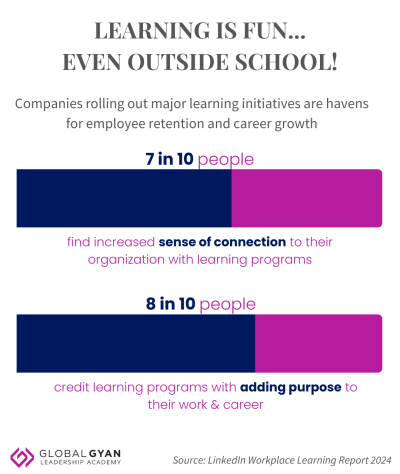Why Leadership Development is the Lifeline for Employee Retention


Here’s a thought: employee retention in this day and age feels like trying to hold water in your hands. No matter how hard you grip, a few drops always seem to trickle through your fingers. Wouldn’t you agree? Companies often face the challenge of keeping their best employees, despite offering perks, health benefits and competitive salaries. But here’s something many businesses overlook: leadership development could be the missing piece in this puzzle.
Leadership plays a huge role in shaping an employee’s experience at an organization (and in their career as a whole). Strong leadership isn’t just about making decisions or managing people; it’s about inspiring, guiding and creating an environment where employees feel valued and heard. When leaders are well-trained and equipped with the right skills, they become mentors who help their teams and employees grow. This sense of growth and support creates loyalty and makes employees less likely to leave. In short, leadership development is directly correlated to employee retention. In this article, we’ll tell you exactly how that is and what you need to do in order to develop your leaders with the right corporate training programs.
Why Leadership Development Matters
Picture a ship without a captain. It might stay afloat, but it won’t go very far. Similarly, an organization without strong leadership can struggle with direction, morale and ultimately, employee retention. The truth is, leadership isn’t just about delegating tasks or meeting targets—it’s about inspiring and empowering people to do their best work in a way that organically drives growth and success.
Ponder this: when employees feel guided, supported and valued by their leaders, they’re more likely to stay. But when leadership is absent or ineffective, disengagement creeps in, and the turnover cycle begins. Hasn’t this been your experience?
In essence, leadership development programs act as the glue that keeps teams intact, especially during challenging times.

How Leadership Development Boosts Employee Retention
1. Creating a Sense of Purpose
Leadership development helps leaders understand the importance of connecting individual tasks to the company’s overarching vision. When leaders communicate how each team member’s work contributes to the overall mission, employees begin to see the value of what they do. This sense of purpose is essential because people want to feel that their work matters.
It’s the difference between just doing a job and building a meaningful career, creating a brand that stands out in the crowd. Employees who understand their role in their organization’s success are more motivated and engaged. They are less likely to look elsewhere when they feel a strong connection to their work that, in turn, drives business goals.
Leadership development programs equip managers with the tools to effectively communicate this purpose, converting routine tasks into meaningful contributions. Ultimately, this renewed sense of purpose drives engagement as well as strengthens loyalty, which in turn significantly boosts employee retention.
2. Promoting Growth and Development
Career stagnation is a major reason employees leave. Therefore, leadership development programs teach managers how to create opportunities for their team members to grow. Whether through mentoring, providing new challenges, or supporting further education, leaders who invest in their employees’ personal and professional growth make them feel valued. This feeling of being nurtured and having a future within the company is a powerful motivator.
Employees who feel they are learning and progressing are more likely to stay because they see a clear path for growth. Leadership development programs help leaders identify these growth opportunities and guide their teams towards them. When employees have the chance to acquire new skills, take on new responsibilities and advance within the company, they feel more satisfied and engaged in their roles, ultimately improving employee retention.
86% of employees believe that training directly impacts morale.
– State of Skills Survey Report, 2024
3. Building Strong Relationships
Good leadership is rooted in strong relationships. And through holistic leadership development programs, managers learn the importance of empathy, active listening and clear communication—skills that are all essential for building trust with their teams. When employees feel heard and valued by their leaders and superiors, they develop a sense of loyalty towards the organization. This loyalty grows when leaders actively promote a supportive environment where feedback is encouraged and employees feel safe to express their ideas and concerns.
Strong relationships between leaders and their teams create a sense of belonging and community within the workplace. Employees who feel connected to their leaders and colleagues are less likely to leave, as they are emotionally invested in the team and the company’s success. This directly impacts employee retention in a positive manner. By prioritising relationship-building, leadership development helps companies retain talent through stronger, more cohesive teams.
4. Encouraging Autonomy and Responsibility
Leadership development teaches managers the delicate balance between guiding employees and empowering to make decisions by themselves. Micromanagement can suffocate creativity and reduce engagement, leading employees to feel undervalued and seeking opportunities elsewhere. On the other hand, leaders who trust their employees and provide them with autonomy foster a sense of ownership.
Employees who are trusted to make decisions and take responsibility for their work are more likely to feel empowered and motivated. This empowerment leads to higher job satisfaction and loyalty, decreasing employee retention by a mile. Leadership development programs equip managers with the skills to delegate effectively, offering support without hovering over their shoulders. When employees feel that they have control over their work and that their input matters, they are more committed to their roles and the organization, improving employee retention rates significantly.
The Ripple Effect of Strong Leadership

Leadership has a unique ripple effect that touches every corner of an organization. When leadership development is prioritized, its impact doesn’t stop at the individual leader—it cascades down to employees, teams and even the entire organizational culture. Just like a pebble thrown into a pond creates expanding ripples, effective leadership spreads its influence far beyond the leader themselves, shaping the overall environment in powerful ways.
At the core of this ripple effect is the concept of empowerment. When leaders are well-trained and well-rounded, they feel confident in their abilities, making them more likely to empower their teams in return. A confident leader trusts their team members to make the right decisions, take initiative and be accountable for their actions. This sense of autonomy isn’t just good for the individual—it boosts team morale, promotes creativity, encourages higher performance and reduces employee retention. When employees feel empowered, they are more engaged and motivated to contribute, creating a positive feedback loop where high performance becomes the norm.
This empowerment also leads to building trust—an essential element in any organization. When leaders show confidence in their team members, employees reciprocate by trusting their leaders. Trust reduces workplace friction and opens the doors for more effective communication. Employees are more likely to share innovative ideas, offer constructive feedback and work collaboratively when they trust that their leader has their back. This improved communication not only enhances the employee experience but also drives better results for the organization as a whole.
And finally, the ripple effect of leadership trickles down to the very culture of the organization. Leadership sets the tone for how work gets done, how people are treated and what values are upheld through various cycles of reinvention. Strong leaders create a culture of accountability, collaboration and continuous improvement, which gradually morphs into the organization’s identity. Leadership development programs not only help leaders mould this vision but also guide them on how to stick to it and strengthen it. Once employees buy into this cohesive purpose, retaining them is cakewalk.
Final Thoughts
The bottom line is simple: leadership development is one of the most effective strategies for improving employee retention. While perks and pay increases can attract talent, it’s strong, empathetic leadership that keeps employees engaged and loyal over the long term. Leaders who are well-trained in communication, empathy and empowerment create an environment where employees feel valued, supported and motivated to grow. This environment naturally perpetuates a sense of loyalty and purpose, reducing the desire to look for opportunities elsewhere.
Investing in the right leadership development program isn’t just about improving the skills of your managers & leaders—it’s about shaping the overall culture of your organization that every employee can get behind; this will directly impact employee retention. When leaders begin to inspire, guide and support their teams, it has a ripple effect that enhances team performance, boosts morale and aligns the workforce with the company’s goals. As a result, organizations not only retain their top talent but also create a workplace culture that attracts new talent.
Simply put, investing in your leaders is an investment in the long-term success of your company. GlobalGyan’s highly customised leadership programs have shaped more than 40,000 thought leaders. Join our success story; get in touch with our representative Kajal Motwani (kajal@globalgyan.in) today!






Responses